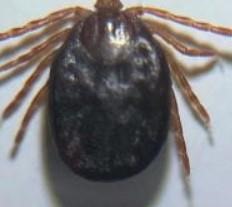By Tim McDermott
The Asian longhorned tick attacks wild and domestic animals and humans. Photo: Anna Pasternak, UK entomology graduate student

Ohio is on the forefront of expansion of ticks and tick-vectored disease going from one tick of medical importance to humans, companion animals, and livestock twenty years ago to five now, adding two new in the past few years. The tick I mentioned way back in the July 23, 2020, edition of the Farm and Dairy article, “The Threat of Asian Longhorned Tick Continues,” was initially discovered on a rescue dog in southern Ohio in summer of 2020. A second detection of Asian Longhorned tick (ALHT) was on a cattle and sheep farm in a neighboring county in the spring of 2021 when the animals were tick-checked while running them through the chute.
Last year right around this time I wrote an article for the March 17th, 2022 All About Grazing column titled “Asian longhorned tick suspected in cattle deaths in southeast Ohio” that detailed the deaths of three head of cattle and noted we had three counties in Ohio with ALHT. Since that time, we have added four more counties bringing our total up to seven. Asian Longhorned ticks have been found so far on cattle, a dog, a grey fox, and a human so far in Ohio. I want to provide a little information so that livestock producers can do their best to keep their animals safe.
Asian Longhorned ticks have the ability to reproduce via parthenogenesis meaning the female can spontaneously lay eggs without needing a male to mate with. This can result in a large population of clones in a space in a short period of time. The ALHT is known to feed on multiple mammalian and avian species including quite a few migratory waterfowl which can result in new populations being established wherever the birds land that has favorable habitat conditions. This tick prefers warm temperatures and high humidity to thrive. The detections we have had with large numbers of ticks on cattle have come in July in pastures that have mature grass stands. This is the ideal environment for ALHT to breed in. Here are some recommendations for producers to keep their cattle tick-safe on pasture:
- Scouting is an important part of integrated pest management to control ALHT. Check cattle as frequently as possible when conditions are right for ALHT. This is during hot and humid weather in paddocks that have longer grass that are the last ones you rotate into or might not have been grazed yet this year.
- Work with your veterinarian if you think you have ALHT on your animals. The products we have labelled for ticks have show to be effective against ALHT so far.
- If you need an extra-label application of tick control, that guidance needs to come from your veterinarian.
- Management intensive grazing with rotation through paddocks to let your animals maintain the pasture will be an important integrated pest management strategy used to control ALHT.
- There are products labelled for pasture application to control ticks that have shown to be effective, but they need to contact the tick in order to work. Application on top of tall grass or mowed grass residue may not contact the tick directly and therefore may not be effective for control. Remember to read, understand, and follow the label for any use of pesticides.
- If you have questions about managing your pasture, contact your local Agriculture and Natural Resources Extension Educator.
Source : osu.edu